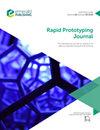Correlation between the part quality, strength and surface roughness of material extrusion process
IF 3.6
4区 工程技术
Q1 ENGINEERING, MECHANICAL
引用次数: 0
Abstract
Purpose The purpose of this study was to develop a correlation between the properties of acrylonitrile butadiene styrene parts 3D printed by material extrusion (MEX) process. Design/methodology/approach The two MEX parameters and their values have been selected by design of experiment method. Three properties of MEX parts, i.e. strength (tensile and three-point bending), surface roughness and the dimensional accuracy, are studied at different build speeds (35 mm/s, 45 mm/s and 55 mm/s) and the layer heights (0.06 mm, 0.10 mm and 0.15 mm). Findings The results show that tensile strength and three-point bending strength both increase with the decrease in build speed and the layer height. The artifact selected for dimensional accuracy test shows higher accuracy of the features when 3D printed with 0.06 mm layer height at 35 mm/s build speed as compared to those of higher layer heights and build speeds. The optical images of the 3D-printed specimen reveal that lower build speed and the layer height promote higher inter-layer diffusion that has the effect of strong bonding between the layers and, as a result, higher strength of the specimen. The surface roughness values also have direct relation with the build speed and the layer height. Originality/value The whole experiments demonstrate that the part quality, surface roughness and the mechanical strength are correlated and depend on the build speed and the layer height.材料挤压工艺的零件质量、强度和表面粗糙度之间的相关性
设计/方法/途径通过实验设计法选择了两个 MEX 参数及其值。研究结果表明,拉伸强度和三点弯曲强度均随构建速度和层高的降低而增加。与更高的层高和构建速度相比,以 35 mm/s 的构建速度、0.06 mm 的层高进行三维打印时,选作尺寸精度测试的工件显示出更高的特征精度。三维打印试样的光学图像显示,较低的构建速度和层高可促进较高的层间扩散,从而使层间产生较强的结合力,进而提高试样的强度。整个实验表明,零件质量、表面粗糙度和机械强度与构建速度和层高相关,并取决于构建速度和层高。
本文章由计算机程序翻译,如有差异,请以英文原文为准。
求助全文
约1分钟内获得全文
求助全文
来源期刊

Rapid Prototyping Journal
工程技术-材料科学:综合
CiteScore
8.30
自引率
10.30%
发文量
137
审稿时长
4.6 months
期刊介绍:
Rapid Prototyping Journal concentrates on development in a manufacturing environment but covers applications in other areas, such as medicine and construction. All papers published in this field are scattered over a wide range of international publications, none of which actually specializes in this particular discipline, this journal is a vital resource for anyone involved in additive manufacturing. It draws together important refereed papers on all aspects of AM from distinguished sources all over the world, to give a truly international perspective on this dynamic and exciting area.
-Benchmarking – certification and qualification in AM-
Mass customisation in AM-
Design for AM-
Materials aspects-
Reviews of processes/applications-
CAD and other software aspects-
Enhancement of existing processes-
Integration with design process-
Management implications-
New AM processes-
Novel applications of AM parts-
AM for tooling-
Medical applications-
Reverse engineering in relation to AM-
Additive & Subtractive hybrid manufacturing-
Industrialisation
 求助内容:
求助内容: 应助结果提醒方式:
应助结果提醒方式:


